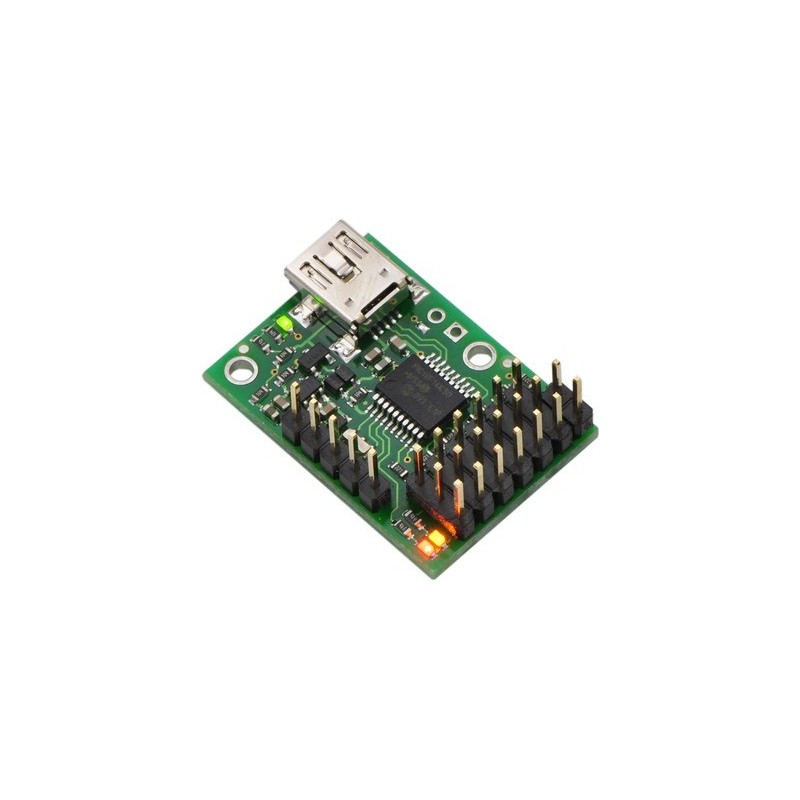



87,97 zł Netto
Pololu Micro Maestro 1350 to kompaktowy, wszechstronny kontroler serwomechanizmów z interfejsem USB i możliwością pracy autonomicznej, przeznaczony do zastosowań w robotyce, animatronice oraz systemach sterowania opartych na PC lub mikrokontrolerach. Dzięki elastycznej konfiguracji kanałów znajduje zastosowanie również jako interfejs do czujników i ekspander I/O.
Micro Maestro to 6-kanałowy kontroler serwomechanizmów firmy Pololu z interfejsem USB, portem szeregowym TTL i możliwością pracy autonomicznej dzięki wbudowanemu interpreterowi skryptów. Pozwala na precyzyjne sterowanie serwami z rozdzielczością 0,25 µs oraz niezależną regulacją prędkości i przyspieszenia dla każdego kanału. Może pełnić funkcję sterownika I/O – umożliwia wykorzystanie kanałów jako cyfrowych wyjść lub analogowych wejść, co pozwala na odczyt czujników i sterowanie urządzeniami peryferyjnymi bez użycia zewnętrznego mikrokontrolera. Zasilanie odbywa się przez USB lub zewnętrzne źródło 5–16 V. Wersja zlutowana posiada zamontowane złącza goldpin.
Producent BTC Korporacja sp. z o. o. Lwowska 5 05-120 Legionowo Polska sprzedaz@kamami.pl 22 767 36 20
Osoba odpowiedzialna BTC Korporacja sp. z o. o. Lwowska 5 05-120 Legionowo Polska sprzedaz@kamami.pl 22 767 36 20
Kabel z wtykami USB typ A oraz mini-USB typ B, kabel o długości 1,8 m
Brak towaru
Pololu Micro Maestro 1351 w wersji kit umożliwia precyzyjne i elastyczne sterowanie serwami oraz czujnikami z poziomu PC lub mikrokontrolera. Dzięki możliwości pracy autonomicznej i wykorzystaniu jako interfejsu USB–TTL, znajduje zastosowanie w systemach sterowania ruchami, projektach animatronicznych oraz układach interaktywnych reagujących na bodźce zewnętrzne.
Brak towaru
Moduł sterownika serwomechanizmów to rozszerzenie przeznaczone dla minikomputerów Raspberry Pi Zero/Zero W/Zero WH/2B/3B/3B+. Pozwala na sterowanie 16 kanałami PWM. Waveshare 15275
Brak towaru
Moduł HAT ze sterownikiem serw PCA9685 przeznaczony do minikomputerów Raspberry Pi. Płytka wyposażona została w złącze 40-pinowe. Adafruit 3416
Moduł z 16-kanałowym sterownikiem PWM PCA9685. Płytka została wyposażona w złącze Grove i komunikuje się przez interfejs I2C. Seeed Studio 108020102
Moduł sterowania serwem o zakresie ruchu 180 stopni, Nie wymaga programowania i jest idealny do operacji takich jak otwieranie i zamykanie ust, dłoni czy oczu. Sterowanie odbywa się za pomocą wbudowanego układu ATTiny13A, przycisku oraz potencjometru, a każdy naciśnięty przycisk przesuwa serwo na drugi koniec zakresu, z możliwością regulacji długości ruchu. Kitronik 2177
Moduł z 8-kanałowym sterownikiem serwomechanizmów. Pozwala na kontrolowanie prędkości ruchu oraz początkowej pozycji serwa. Cytron SC08A
Pololu Mini Maestro 1355 to kontroler serwomechanizmów z 18 konfigurowalnymi kanałami, przeznaczony do precyzyjnych aplikacji w robotyce, automatyce i animatronice. Wersja kit pozwala dostosować sposób montażu złączy do potrzeb projektu, a bogata funkcjonalność umożliwia tworzenie autonomicznych systemów sterowania oraz rozbudowę interfejsu wejść/wyjść w systemach embedded.
Brak towaru
Płytka DFRobot DRI0057 umożliwia sterowanie rozbudowanymi systemami serwomechanizmów z wykorzystaniem interfejsów USB lub UART i zapewnia pełną dwukierunkową komunikację z serwami. Zaprojektowana do zaawansowanej robotyki i aplikacji wymagających precyzyjnej synchronizacji wielu napędów.
Kompaktowy sterownik XIAO Bus Servo Adapter z modułem XIAO ESP32-C3, umożliwiające precyzyjne sterowanie serwomechanizmami ST/SC przez interfejs UART. Dzięki solidnej konstrukcji i zasilaniu 5–12 V pozwala na jednoczesną kontrolę wielu serw, co sprawdza się w robotach humanoidalnych, sześcionożnych i ramionach robotycznych. Wsparcie Arduino IDE, otwarta architektura oraz łatwy montaż czynią go doskonałym narzędziem do edukacji, prototypowania i zaawansowanych projektów robotycznych. Seeed Studio 114993612
Adafruit Motorshield to shield umożliwiający łatwe sterowanie silnikami DC, krokowymi oraz serwomechanizmami przy pomocy Arduino. Zawiera sterowniki silników DC, krokowych oraz wyjścia do sterowania serwomechanizmami. Umożliwia adresowanie oraz łączenie ekspanderów (do 32) i sterowanie przy pomocy jednej płytki Arduino. Adafruit 1438
Płytka rozszerzeniowa do minikomputera Raspberry Pi dodająca możliwość sterowania do 16 serw sygnałem PWM. Potrafi generować sygnał do 1,6 kHz z 12-bitową rozdzielczością. Dzięki sterowaniu za pomocą interfejsu I2C, do równoczesnego sterowania serw wystarczy użycie 2 pinów. Adafruit 2327
Mini Maestro 12 w wersji kit to wielofunkcyjny kontroler do sterowania serwami, odczytu czujników i realizacji sekwencji ruchów bez komputera. Doskonały do zastosowań w robotyce, animatronice i systemach interaktywnych, umożliwia elastyczne sterowanie ruchem i obsługę peryferiów z poziomu PC lub mikrokontrolera.
Brak towaru
Pololu Micro Maestro 1351 w wersji kit umożliwia precyzyjne i elastyczne sterowanie serwami oraz czujnikami z poziomu PC lub mikrokontrolera. Dzięki możliwości pracy autonomicznej i wykorzystaniu jako interfejsu USB–TTL, znajduje zastosowanie w systemach sterowania ruchami, projektach animatronicznych oraz układach interaktywnych reagujących na bodźce zewnętrzne.
Brak towaru
Rozszerzenie typu shield dla Arduino ze sterownikiem PWM 16-kanałowym, 12-bitowym pozwalającym na równoczesne sterowanie 16 serwomechanizmami za pomocą interfejsu I2C. Adafruit 1411
Brak towaru
Moduł sterownika serwomechanizmów PCA9685 dedykowany dla płytek edukacyjnych micro:bit. Pozwala na sterowanie 16 kanałami PWM. SB Components 09183
Brak towaru
Uniwersalny tester serwomechanizmów oraz regulatorów ESC. Umożliwia sprawdzenie działania serwa bez potrzeby korzystania z nadajnika i odbiornika

Pololu Micro Maestro 1350 to kompaktowy, wszechstronny kontroler serwomechanizmów z interfejsem USB i możliwością pracy autonomicznej, przeznaczony do zastosowań w robotyce, animatronice oraz systemach sterowania opartych na PC lub mikrokontrolerach. Dzięki elastycznej konfiguracji kanałów znajduje zastosowanie również jako interfejs do czujników i ekspander I/O.
